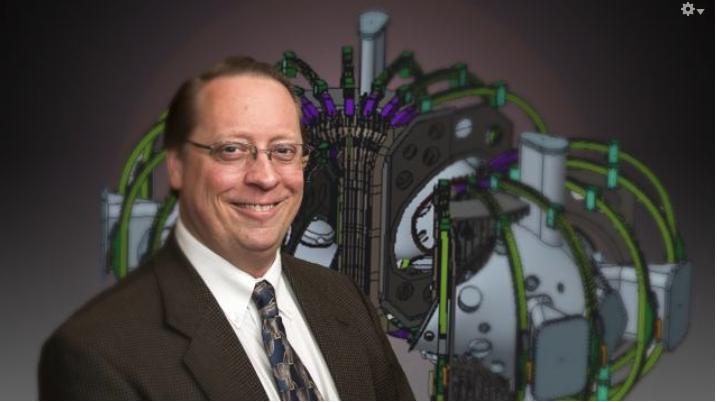
Credit: Collage by Elle Starkman/PPPL Office of Communications.
The U.S. Department of Energy’s (DOE) Princeton Plasma Physics Laboratory (PPPL) has been awarded the lead role in a grant worth $3 million in DOE Advanced Research Projects Agency-Energy (ARPA-E) funding for the design and construction of permanent magnets far more powerful than those on refrigerator doors to facilitate the development of fusion energy. Such magnets could provide a highly innovative basis for simplifying stellarators, complex facilities for experiments in producing fusion energy. Complementing the ARPA-E award for the three-year project is $1 million from the Fusion Energy Sciences office of the DOE Office of Science.
Stellarators, twisty plasm) fusion devices invented by PPPL founder Lyman Spitzer in the 1950s, have long played a secondary role to doughnut-shaped tokamak fusion facilities, which scientists use around the world in the effort to capture and control on Earth the fusion energy that powers the sun and stars. A key advantage of stellarators is their ability to run without the risk of damaging disruptions that must be carefully controlled in tokamak facilities. However, the complex design of twisty stellarators has held back their development.
New type of stellarator
“If we succeed, this project will provide the basis for an attractive new type of stellarator that doesn’t use intricate and expensive magnetic coils,” said PPPL physicist David Gates, who leads the team that developed the ARPA-E proposal and who will head the design of the magnets and measure the magnetic field that the completed work produces.
Approval of the project creates a new stage of development for PPPL, which has long been a world leader in exploring the science behind controlled fusion energy. “I couldn’t be more excited about this program,” PPPL Director Steve Cowley said. “Permanent magnets may enable simpler and cheaper fusion devices.”
The Laboratory will develop the magnets in partnership with SABR Enterprises, a North Andover, Massachusetts, company that specializes in constructing permanent magnet assemblies. Assisting the design will be Auburn University, which has a small stellarator program of its own.
The PPPL project is among the 15 proposals approved for a total of $32 million by the ARPA-E “Breakthroughs Enabling THermonuclear-fusion Energy (BETHE)” program, which aims to promote lower cost and commercially viable fusion energy concepts. The permanent magnet award comes under the BETHE category of “Technology Development to Lower the Cost of More Mature Concepts.” Hans Bethe, after whom this program is named, was a Nobel Prize laureate in physics who in the early 1930s discovered that stars shine due to fusion reactions in their cores.
Widely recognized promise
The promise of fusion energy is widely recognized. “Fusion energy technology holds great potential to be a safe, clean, reliable energy source, but research and development of fusion technology is often constrained by prohibitive costs,” said DOE Under Secretary of Energy Mark W. Menezes. “These BETHE projects,” said ARPA-E Director Lane Genatowski, “further advance ARPA-E’s commitment to the development of fusion energy as a cost-competitive, viable, energy generation source.”
For PPPL physicist Gates, a simplified stellarator could become an attractive candidate for a fusion pilot plant. “We hope this project will be the start of a program based on permanent magnets,” he said, “a program that will take the risk out of designing and building these machines.”
###
PPPL, on Princeton University’s Forrestal Campus in Plainsboro, N.J., is devoted to creating new knowledge about the physics of plasmas — ultra-hot, charged gases — and to developing practical solutions for the creation of fusion energy. The Laboratory is managed by the University for the U.S. Department of Energy’s Office of Science, which is the single largest supporter of basic research in the physical sciences in the United States and is working to address some of the most pressing challenges of our time. For more information, visit energy.gov/science.
Media Contact
John Greenwald
[email protected]
Original Source
https:/




